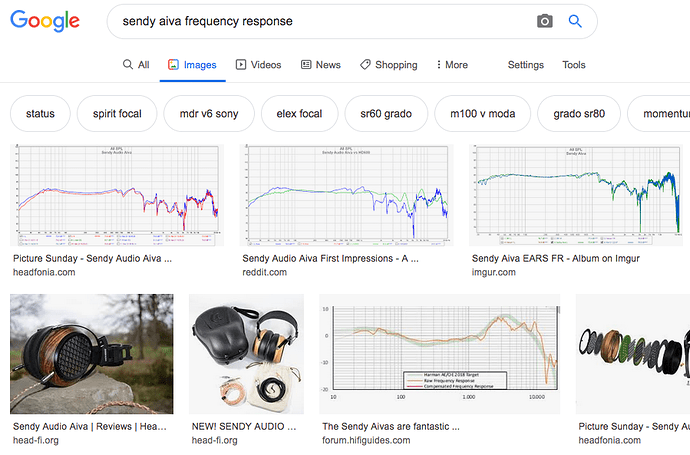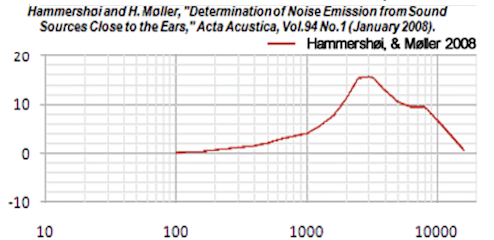ah, they are my favorite after the Elex.
doesnt that muffled sound bother you? their so dark
I personally wouldn’t call them dark,they sound pretty reasonably pretty bright. LCD2C and Senn 650/600 are darker IMO. They have some of the best timbre and natural sound with instrumental music I’ve heard.
Well this is hilarious. Occurred to me to check what graphs are available for the Aiva to see whether we could glean anything more about it. So I did a google search with this result:
Three copies of the same graph you posted but none of them attributed to the actual source, which is the Aiva review by Jonathan Parks AKA Resolve Reviews. But the fourth graph looked truly bizarre to me. So clicked on it – and was taken to a post I had made in response to you regarding the Aivas back when you bought them! (The Sendy Aivas are fantastic! - #28 by M0N)
That graph is a screen grab of Oratory1990’s measurements of the Orpheus HE-1 that I used as an example of a point I was making in my comment. So anyone who isn’t careful or doesn’t understand FR graphs might mistake the HE-1 graph for an Aiva graph, lol! (I’ve got to remember to label all graphs I post right on the image itself.)
Getting back to the Aiva’s graph. Best guess is that is was compensated with MiniDSP’s HPN compensation curve, which in turn is apparently their version of the diffuse field curve. The DF curve traditionally looks like this:
IOW, a flat bass, gently rising mids but a massive upper mids peak topping out at roughly 15.5 dB. Due to a misunderstanding fostered by Sennheiser and probably others, DF is not a realistic version of accuracy but a large segment of the headphone community is used to graphs based on it. IAC, if we translate from DF to Harman or something along those lines, we have to add between 3 and 5 dB to a DF compensated graph at 3 kHz and taper off both before and after that. The upshot is that Resolve’s graph of the Aiva seems to show that it is recessed throughout most of the upper mids and treble. But in fact it may well show as only being recessed between 2 and 3 kHz if the graph were compensated by a Harman-like target.
It looks like all of them tested entirely different headphones, or mixed up graphs or something.
I’m posting 'way too much in the thread I started, but I just can’t help responding to this:
What a perfect example of graphs complementing verbal descriptions and vice versa. Here’s the Oratory1990 measurement of the Neumanns:
(It’s only the graph in the upper left corner that is relevant. Everything else has to do with EQ. Let’s see if Google manages to scrape a linked graph out of this thread rather than a pasted one…)
To me this graph says the headphone has an emphasized bass that extends a bit too far into the mids (to 400 Hz instead of 250) creating a bit of the very common mud region bloat. Then it fails to rise toward the upper mids and is thus noticeably recessed between 1 and 3 kHz. After that it looks to have an exceptionally nice treble.
Assuming the graph matches the sound of the pair of Neumanns both of you have/had, then the graph pretty much supports both your perceptions (big assumption!). Technically, Ant probably shouldn’t have used the word dark (treble roll-off) as an equivalent to muffled, but the combination of a bit of mud plus upper mids recession certainly warrants being described as muffled in my book. Yet there’s that beautiful treble that Giova is reporting.
Frankly, I suspect it comes down to both of you tending to listen to different music. Some music will have little content that is noticeably affected by the mud+recess and other music might well red-flag it to anyone’s ears. The DT 1990s I use for music listening has pretty much the same issues. So one piece of music will sound at least tolerable but the next will make me cringe.
Honestly google images is just like that. Search for an actor/actress and you’ll get pictures of his/her friend too, etc. You have to click and look at the source.
If someone has two graphs for two different headphones on one page, there’s a 50% chance google will show you the wrong graph, or a graph with pads swapped, or a graph with mods. I mean, search for “T50RP graphs” on google images. Good luck.
Yes this a million times this.
I find recordings I find poor on one headphone/Amp combo, will sometimes come alive on another.
If we can get away from the flat line response is good mentality.
Really where all of this measurement needs to start is understanding what people perceive to be “good”, is there even consistency there?
Clearly people have different preferences, but can we classify people into a smaller number of buckets to make recommendations easier?
Yes. A flat response is only good for four things so far as I can think. A) If you want accurate timbre, spatial placement, etc. when listening to acoustic music. B) If you want a good tuning compromise because you listen to a wide variety of genres on the same headphone. C) A hypothetical reference point for ease of comparing headphones. D) Certain aspects of recording studio work.
Variation in outer ear shape, ear canal shape and length, genre preferences, recency bias, and many other factors ensure there is no one-size-fits-all sonic goodness.
I think that’s what Zeos and DMS do with the headphones portion of their HiFi Guides purchase recommendation app. They divide sound signatures into dark, mid-forward, neutral, v-shaped, bright, and warm. Of course this presumes a degree of audio self-knowledge that the vast majority of consumers will draw a blank on. And veteran headphone enthusiasts will have that sorted out. It’s those who are new to the hobby who will find these categories a bit unclear. Seems to me that the quickest way to get up to speed for most of us would be to experiment with EQ.
I don’t think you need a flat signature to achieve this tbh
Yes
Can’t see how it could be otherwise, at least for timbre. Timbre is produced by the relative strengths of upper partials AKA overtones. Let’s say the fundamental is A 440. If there is a dip or rise that covers 880 Hz, for example, then timbre will be affected.
As for spatial placement, I’m just going off theory, since my hearing damage messes up my ability to hear this. But if there’s a dip in the mids then any instrument or voice sounding in that range would sound quieter than instruments or voices sounding outside that dip. I’d think something that is quieter than expected would be translated by the brain as being further away. And of course if louder than expected, the opposite.
That is somewhat correct, but I assume we can agree studio flat (flat line) does not sound realistically neutral? This is just me going off of my experience. For example, if I take the focal clear and eq it to studio flat, the timbre becomes less accurate imo. Stock it sounds better. I think there are some more things that goes into timbre, but for tone I would somewhat agree with what you say.
By studio flat do you mean headphones that measure and sound essentially identically to your studio monitors – and timbres sound accurate on the monitors but not on the headphones?
I mainly mean something that measures like a flat line, typically only achieved with eq
With studio monitors, the room plays a big role in the response so that would be a more complicated topic
Measuring in a flat line – I can only assume you mean that loosely or have some compensation curve in mind. A headphone FR curve that doesn’t have an ear amplification hump would sound horrid.
Sorry for the confusion yes there will be compensation
Not really super into the technical side of things lol. I use eq for headphones vary rarely (although I eq headphones and audio for studio all the time), so I really haven’t taken the time to fully understand graphs
From past posts I remember you use Sonarworks to EQ your Clears for studio use. Frankly, I think what you’re saying about them not being as timbrally accurate as stock is due to the SW profile, not any fundamental conflict between accurate tuning and accurate timbre.
A) Sonarworks profiles are made to match their house conception of what a flat sound is. B) Sonarworks profiles for a given model headphone are a compromise between the differing tunings of multiple units of the same model headphone. I’ve seen posts from Sonarworks showing graphs of just how much variance they have to deal with. And that means just how likely it is that any such profile will be accurate for your particular Clear (Pro) headphone.
I sent in my clears to sonarworks so I have a specific profile
Yeah I figured it was their version of neutral, but it just worked the best for me compared to other options
Also I should really clarify that I was trying to say that there are some headphones that I would not say are neutral but have a pretty accurate timbre
I was going to post: “Hopefully that eliminates my point B. So back to point A” – then your second paragraph appeared, lol.
And I should have guessed that the cost of the custom profile would not have stood in the way of your getting that done.
You said eariler:
We both agree that at one point at least the Harman target had too much bass. This is because they were matching the frequency response of their reference speaker system in their reference testing room. The FR graph for that set-up is on-line, and it’s 'way over-done in the bass, like a strong low shelf filter was applied. (Presumably, this is because their reference system was designed for maximum consumer preference, not according to some abstract flatness principle.)
Sonarworks made their best stab at coming up with a reference FR. So did the guy at Rtings.com. Such attempts tend to fail, and IAC there are maybe a dozen such reference FR curves out there and they can’t all be right, lol,

